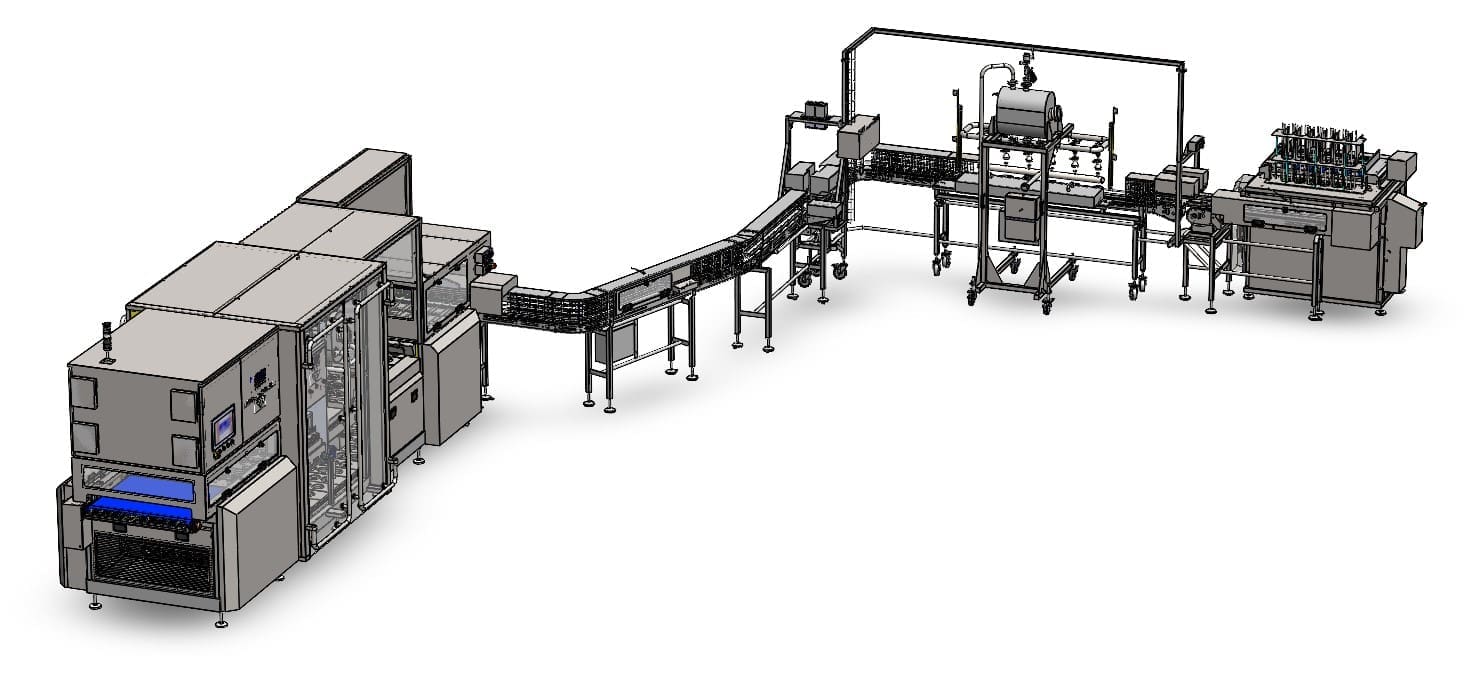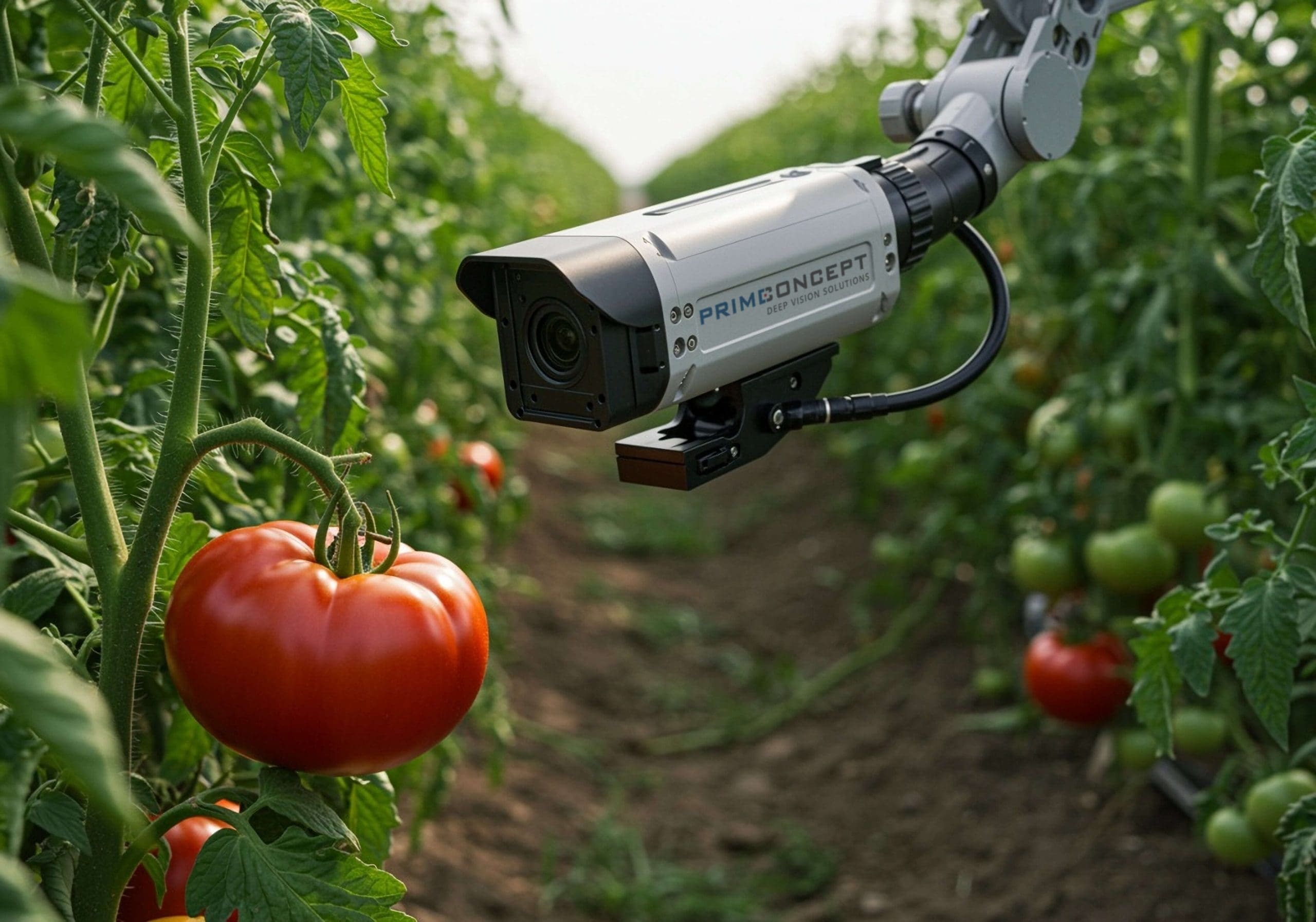The efficiency of a bottling and packaging plant whose daily output reaches millions of bottles depends also on end-of-line operations which need to be perfectly synchronized one another.
Smipal, that is SMI division specialized in the production of automatic palletizing systems, offers reliable cutting-edge solutions like the APS P series, the evolution of the APS Plus series. The APS P model features a SCARA arm, integrating in the central column the operations of palletizing, empty pallet feeding and pad insertion, i.e. three different operations usually performed by separate machines inside their own dedicated space.
The new Smipal palletizers of the APS P series, besides the stand-alone version, can be integrated in a Packbloc Neo compact system, gathering in a unique, small sized plant the operations of an automatic shrinkwrapper or an automatic wrap-around casepacker together with an automatic fixed-column palletizer and a turnplate pallet wrapper.
The integration of multiple machines offers considerable advantages from the standpoint of operational flexibility and reduction of costs and energy consumption, as it reduces the need to install long stretches of conveyor belts (usually required to connect various standalone units to one another), allowing a single operator manage the entire system.
The integrated Packbloc Neo system, recently presented by SMI at Brau Beviale 2014 included a Smiflexi model LWP 30 wrap-around case packer built into a Smipal model APS 1550 P palletizer, which in turn integrated a turntable wrapping machine into its own structure.
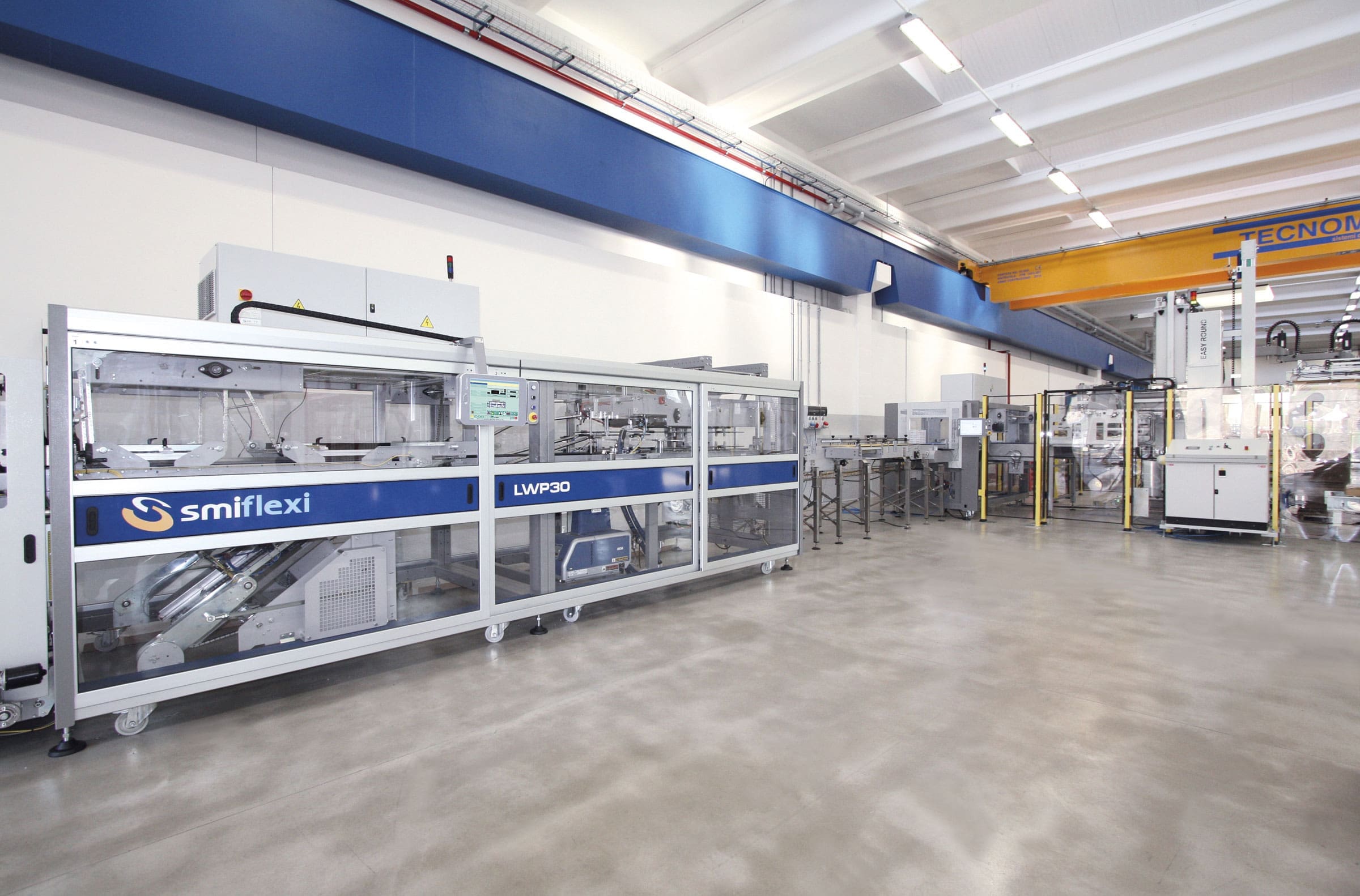 Sturdy and elegant packages with the LWP 30 case packer
Sturdy and elegant packages with the LWP 30 case packer
The automatic LWP 30 wrap-around case packers produced by SMI, suitable for production speeds up to 30 packs per minute, stand out in the packaging machine market for a number of technical features which place them at the top of the reference range.
Machine adjustments in these systems are made by means of convenient cranks and useful numeric counters, which allow the operator to switch from one pack format to another simply, quickly and accurately without having to use any tools. The cardboard blanks are picked up by a mechanical system that ensures precise synchronization with the other operations performed by the packaging machine; the blanks used in making the finished boxes are transferred from the cardboard blanks magazine to the main work surface smoothly and uninterruptedly, by an innovative up-going, slightly curved system that significantly improves continuity in the feeding of the packaging material.
Smiflexi’s LWP series new wrap-around case packers have a compact and solid frame, able to adapt easily to any logistic condition and also mount brushless motors that drive the axes, which allows the user to reduce energy consumption.
A more efficient production thanks to new control systems.
The LWP series packaging machines can also be equipped with accessory devices that increase their level of efficiency such as, for example, the webcam control system. It is mounted at packer outfeed to inspect every single pack produced, to detect its size characteristics and correct closing; it also rejects any pack automatically, in case it does not comply with the quality parameters entered in the production program.
The foregoing control system can be further automated by installing a new device for ejecting and unloading of defective packs consisting of a conveyor belt that runs on free ball bearings. This belt carries the non-conforming pack to the outside of the production line by gently acting on the bottom of the pack instead of pushing it abruptly on the sides (as occurs in traditional ejection systems).
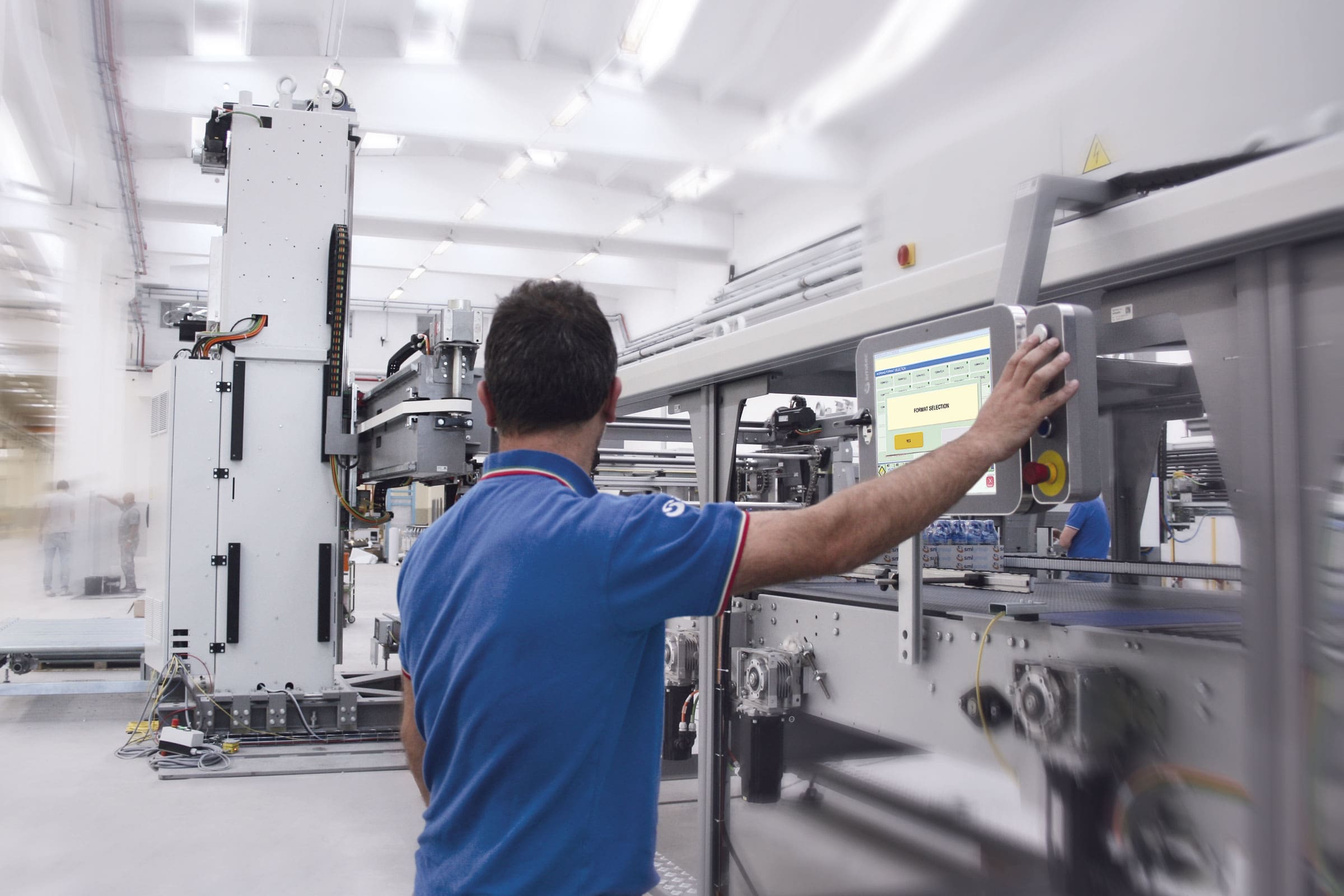 The APS 1550 P automatic palletizer
The APS 1550 P automatic palletizer
The heart of the compact and integrated Packbloc Neo system is the new Smipal APS 1550 P palletizer which houses all the movable mechanical components within the fixed central column, i.e.: the cross-member that supports the layer-loading head that moves up and down on the column, the layer-loading head which performs fast and accurate horizontal movements along the cross-member thanks to a telescopic guides system and, finally, an articulated arm based on SCARA technology, which performs both vertical and horizontal movements to feed the empty pallets and insert the cardboard pads between layers.
All the vertical and horizontal movements of the mechanical components of this SMI palletizing system are managed by the machine’s automation and control system, which establishes precise and coordinated trajectories for each one, in perfect synch with the operations performed by the layer-loading head, so that the machine’s various components will never touch or interfere with one another.
 Continuous-flow layer formation
Continuous-flow layer formation
Among the innovative features of the new Smipal APS 1550 P model palletizer, is the machine’s infeed section with the layer pre-composition system, which comprises a pack rotation device equipped with belts running on free ball bearings, a row-formation belt and a layer-formation belt. In the new system proposed by Smipal, packs are rotated in the palletizer’s infeed section, before the row is formed, through an innovative conveyor belt fitted with free ball bearings. By setting this function in the palletizing pattern, these bearings impart rotary motion to the bottom of the transiting pack. This feature avoids the drawbacks linked to traditional pack-turning systems in which the pack is turned by making it collide against a fixed blocking element located above the sliding belt.
Efficient end of line with the integrated turnplate pallet wrapper
The compactness and efficiency of the Packbloc solution proposed by SMI were further enhanced by the Neo version, integrating a turnplate pallet wrapper in the palletizer’s structure, which wraps the individual layers as soon as they are placed on the pallet.
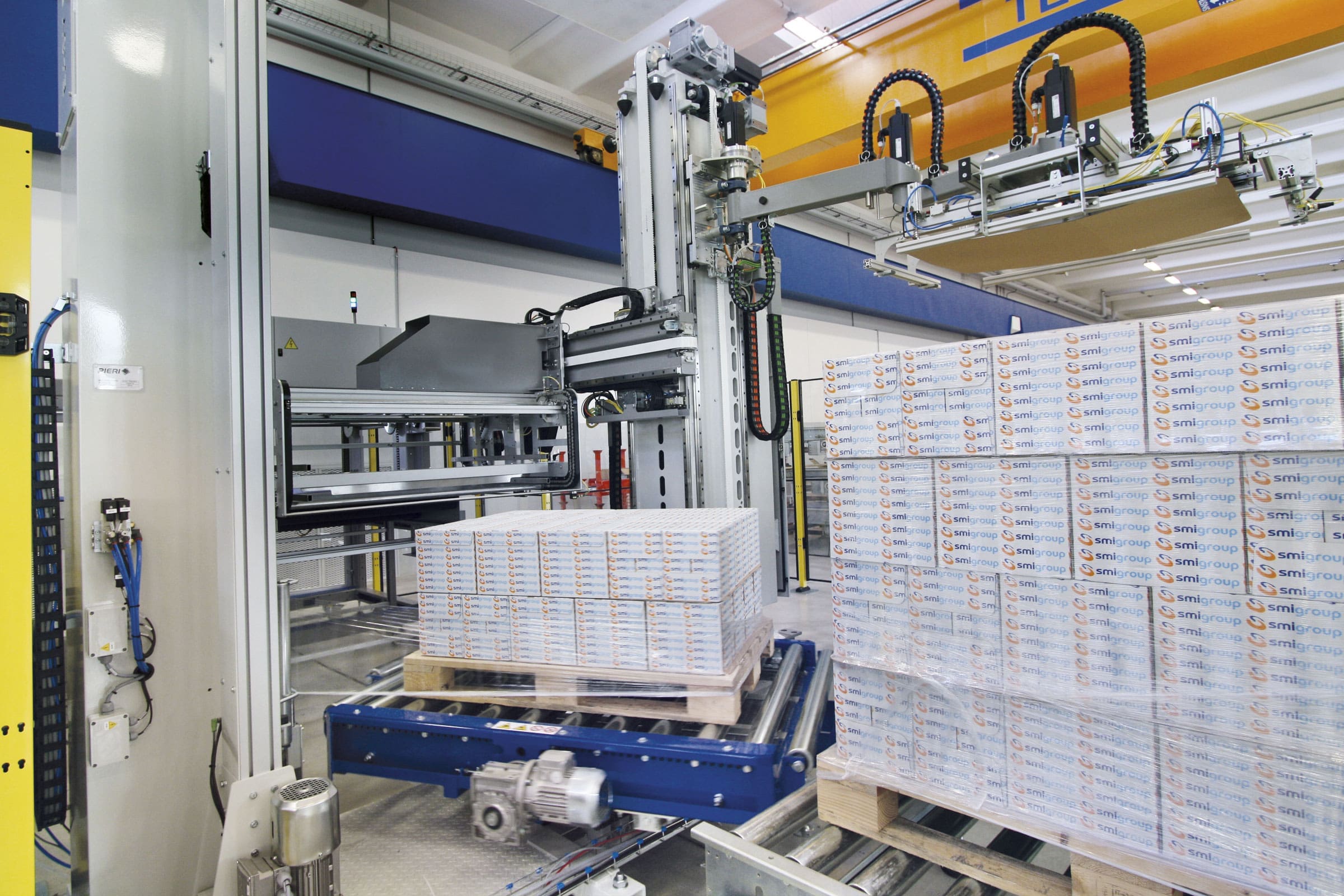 In fact, the configuration of the Packbloc Neo packaging system featured the wrapping of the pallet in wrap-around film simultaneously with the formation of its layers, thereby eliminating dead time typical of other solutions in which the wrapping takes place once the pallet is finished. This solution is especially suited to the palletizing of unstable containers such as, for example, loose 5 to 10-liter bottles not packaged in cardboard trays and which remain firmly placed on the pallet, as it advances on the machine’s conveyor belts, thanks to the wrapping of the single layer.
In fact, the configuration of the Packbloc Neo packaging system featured the wrapping of the pallet in wrap-around film simultaneously with the formation of its layers, thereby eliminating dead time typical of other solutions in which the wrapping takes place once the pallet is finished. This solution is especially suited to the palletizing of unstable containers such as, for example, loose 5 to 10-liter bottles not packaged in cardboard trays and which remain firmly placed on the pallet, as it advances on the machine’s conveyor belts, thanks to the wrapping of the single layer.

